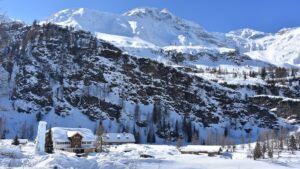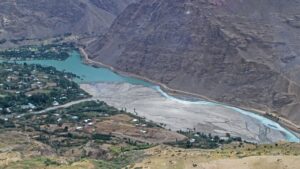ID09: Atmospheric dynamics over cold regions in a large-scale context
Details
Full Title
Atmospheric dynamics over cold regions and their bridging function to the larger-scale climate
Scheduled
Wednesday, 2022-09-14
13:30 - 15:00Convener
Co-Conveners
Jenny Victoria Turton and Tobias Sauter
Assigned to Synthesis Workshop
–
Keywords
climate change, cold regions, atmospheric modeling, climate dynamics, cryosphere
Description
Mountains from the tropics to the polar zones have undergone obvious environmental changes for many decades, most notably by receding glaciers. Knowledge of the physical mechanisms, which transmit large-scale climate change to these “cold regions”, remains nonetheless unsatisfying. In particular, how mesoscale processes act as a bridge in both directions, on the one hand to the large-scale climate dynamics and, on the other, to local surface-layer dynamics, is still an understudied area of research. In this session we address such multi-scale linkages for mountain ranges worldwide, and bring together dynamical meteorology/climatology and cryospheric sciences. Possible mechanisms at different scales could be climate-mode driven flows, insolation-driven diurnal circulations, atmospheric rivers, or katabatic winds. High-resolution dynamical modeling, observations, detection and attribution, or machine-learning approaches can all be considered to identify the physical linkages. They will ultimately help to project climate change in cold regions on a stronger process-oriented basis.
Registered Abstracts
Abstract ID 661 | Date: 2022-09-14 13:30 – 13:47 | Type: Oral Presentation | Place: SOWI – Seminar room SR2 |
Wang, Xun; Schmidt, Benjamin; Otto, Marco; Scherer, Dieter
Chair of Climatology, Technische Universität Berlin, Germany
Keywords: Climate Change, High Mountain Asia, Dynamical Downscaling
High Mountain Asia (HMA), also known as the “Third Pole”, is the largest reservoir of glaciers outside the polar regions. On average, glaciers have retreated over HMA, except for the Pamir-Karakorum-western-Himalaya region. Under the background of global warming, glacier retreats and consequential expansion of glacier lakes will increase the risk of glacier-related natural hazards, such as landslides and glacial lake outburst floods.
To understand the physical linkage between local-scale glacier changes and large-scale climate, it is essential to investigate climate change over the past decades in HMA. Although this topic has already been extensively studied, some inconsistencies and open questions still remain. For example, climate change over high-elevated areas (> 5000 m a.s.l.), where most glaciers are located, is still not fully understood mainly due to the lack of meteorological stations at high elevations.
Using the high-resolution, long-term High Asia Refined analysis version 2 (HAR v2), we are able to analyze trends and spatio-temporal patterns of essential climate variables, such as precipitation and air temperature, for the HMA region from 1981 to 2020. The HAR v2 was generated by dynamical downscaling of ERA5 using the Weather Research and Forecasting model. With a high spatial resolution of 10 km, the HAR v2 has a more realistic representation of complex terrains over HMA. Thus, the HAR v2 would exhibit more detailed regional-scale patterns than its forcing data ERA5. In addition, the linkage between the detected large-scale climate change and local changes of glaciers is discussed, with a focus on the Halji glacier (~5300 m a.s.l.) located in northwestern Nepal.
Abstract ID 687 | Date: 2022-09-14 13:47 – 14:04 | Type: Oral Presentation | Place: SOWI – Seminar room SR2 |
Curio, Julia; Kukulies, Julia; Chen, Deliang
University of Gothenburg, Sweden
Keywords: Tibetan Plateau, Mesoscale Cyclones, Extreme Precipitation, Large-Scale Circulation, Mesoscale Convective Systems
Mesoscale Tibetan Plateau vortices (TPVs) have been identified as major precipitation bearing systems in the Tibetan Plateau (TP) region. TPVs originate over the TP and, while the majority of TPVs remain on the TP throughout their lifetime, a fraction of TPVs (~20%) moves east off the TP into densely populated downstream regions, such as the Sichuan basin and the Yangtze river valley. These moving-off TPVs can pose a risk for people’s life and livelihoods, by causing heavy rainfall and subsequent flooding and landslides amplified by the complex terrain.
In this study we analyse how the occurrence and behaviour of TPVs is related to the large-scale circulation with a focus on the position and strength of the subtropical westerly jet, and the roles played by TPVs for precipitation events downstream of the TP.
Results from a case study, using reanalysis and satellite data, show that in July 2008 a TPV triggered the formation of a mesoscale convection system (MCS) as it moved eastward off the TP, leading to heavy precipitation in the Sichuan basin. A set of high-resolution model simulations suggest that the moving-off TPV indeed plays a key role for the initiation of the MCS and the ability of the simulation to capture the observed precipitation in the Sichuan basin.
In a further step we analyse the relationship between heavy precipitation events, MCSs and TPVs on a climatological basis using observations, reanalysis data and regional downscaling. Improved understanding of how the combination of favorable large-scale atmospheric conditions and occurrence of TPVs and MCSs can create and affect heavy/extreme precipitation events on the TP and in its downstream regions might enable us to improve their forecasts and projections in a climate change context.
Abstract ID 400 | Date: 2022-09-14 14:04 – 14:21 | Type: Oral Presentation | Place: SOWI – Seminar room SR2 |
Haugeneder, Michael (1,2); Lehning, Michael (1,2); Jonas, Tobias (1); Mott, Rebecca (1)
1: WSL-Institut für Schnee- und Lawinenforschung SLF, Switzerland
2: School of Architecture, Civil and Environmental Engineering, École Polytechnique Fédérale de Lausanne, Switzerland
Keywords: Snow-Atmosphere Interaction, Patchy Snow Cover, Lateral Heat Advection, Snow Melt, Eddy Covariance
Snow-atmosphere interactions drive the mass and energy balance of the snow pack throughout the whole snow season. In late spring, when the snow cover gets patchy, the extreme surface heterogeneity induces complex atmospheric processes as the lateral advection of heat or the development of thin stable internal boundary layers (SIBL) over the leading edge of snow patches. We aim at a better understanding of these near-surface atmospheric processes.
Therefore, we conducted a comprehensive field campaign at an alpine research site. We measured meteorological parameters, snow ablation patterns, and turbulence characteristics using eddy-covariance sensors. Additionally, we applied a novel experimental method. A high resolution thermal infrared camera records a 30Hz sequence of infrared frames. The camera points at vertically deployed thin, synthetic screens. The screens cover a horizontal distance of 6m across the transition from bare ground to snow. The surface temperature of the screens serves as a proxy for local air temperature. The recorded air temperature fields capture the dynamics of turbulent eddies adjacent to the surface depending on different parameters such as wind speed or the snow coverage. A thin SIBL develops above the leading edge of a snow patch possibly protecting the snow surface from warmer air above. However, sometimes the warm air entrains into the SIBL and reaches down to the snow surface adding further energy to the snow pack.
To quantify exchange processes from observed spatio-temporal dynamics, we developed a method to estimate a near-surface 2D wind field from tracking temperature pattern on the screens. Resulting vertical profiles of air temperature, horizontal and vertical wind speeds can be evaluated with a high spatial (0.01m) and temporal (30Hz) resolution.
Combining the screen measurements with data from eddy-covariance sensors enables us to gain an extensive overview of the (sub)meter scale heat exchange processes. For example, we can investigate the influence of laterally advected heat on vertical turbulent sensible heat fluxes within the atmospheric layer adjacent to the surface.
Furthermore, using terrestrial laser scanning and UAV imaginary we can connect small scale heat exchange processes to ablation rates and pattern over a few hectares.
With the data we aim to better understand and quantify small scale energy transfer processes over patchy snow covers and their dependency on the atmospheric conditions. This will ultimately allow to improve parameterizations of these processes in coarser resolution snow melt models.
Abstract ID 246 | Date: 2022-09-14 14:21 – 14:38 | Type: Oral Presentation | Place: SOWI – Seminar room SR2 |
Aggarwal, Anubha; Kumar, S. Anbu
Delhi Technological University, India
Keywords: Downscaling, Mass Balance, Himalayan Glacier
In this study monthly Temperature Lapse Rates and basic downscaling technique of subtracting means are used to reconstruct temperature (T) series over East Rathong glacier by using multiple data sets from Automatic Weather Stations (AWS) at Himalayan Mountaineering Institute (HMI), Gangtok Indian Meteorological Department (IMD), Yuksum and climate model data. Precipitation (P) over glacier is estimated using Gangtok IMD data and downscaled climate model data. The precipitation from climate model data is downscaled using local scaling factor method. The precipitation computed is found to be in agreement with the precipitation data obtained from AWS at HMI base camp located near the glacier. Change in volume of 0.18 km3 (from 1962 to 2020) estimated using satellite data are used to construct Mass Balance (MB) series for the glacier. It is observed that the glacier is losing its mass with increasing temperature, Aerosol Optical Depth (AOD), from 0.1 in 1980 to 0.2 in 2020, and decreasing precipitation. Regression analysis of MB with T, AOD and P suggest that all three are important parameters which impact the MB of the glacier.
Abstract ID 258 | Date: 2022-09-14 14:38 – 14:55 | Type: Oral Presentation | Place: SOWI – Seminar room SR2 |
Capozzi, Vincenzo; De Vivo, Carmela; Budillon, Giorgio
Department of Science and Technology, University of Naples “Parthenope”, Italy
Keywords: Snowfall Variability, Long-Term Changes, Large-Scale Atmospheric Circulation, Teleconnection Indices
This work presents a new, very long snowfall time series collected in a remote site of Italian Apennine mountains (Montevergine Observatory, 1280 m a.s.l.). After a careful check, based on quality control tests and homogenization procedures, the available data (i.e. daily height of new snow) have been aggregated over winter season (December-January-February) to study the long-term variability in the period 1884-2020. The main evidences emerged from this analysis lie in (i) the strong interannual variability of winter snowfall amounts, in (ii) the absence of a relevant trend from late 19th century to mid-1970s, in (iii) the strong reduction of the snowfall amount and frequency of occurrence from mid-1970s to the end of 1990s (-45 and -17% compared to the average recorded in 1884-1975 period, respectively), and in (iv) the increase of average snowfall amount and frequency of occurrence in the last 20 years.
Moreover, this study shed light on the relationship between the snowfall variability observed in Montevergine and the large-scale atmospheric circulation. Six different synoptic types, describing the meteorological scenarios triggering the snow events in the study area, have been identified by means of a cluster analysis, using two essential atmospheric variables, the 500-hPa geopotential height and the sea level pressure (both retrieved from the third version of Twentieth Century Reanalysis dataset). Such patterns trace out scenarios characterized by the presence of a blocking high-pressure anomaly over Scandinavia or North Atlantic and by a cold air outbreak, involving both maritime and continental cold air masses. A further analysis demonstrates that the identified synoptic types are strongly related with different teleconnection patterns, i.e. the Arctic Oscillation (AO), the Eastern Atlantic Western Russia (EAWR), the Eastern Mediterranean Pattern (EMP), the North Atlantic Oscillation (NAO) and the Scandinavia pattern (SCAND), that govern the European winter atmospheric variability. The relevant decline in snowfall frequency and amounts between 1970s and 1990s can be mainly ascribed to the strong positive trend of AO and NAO indices, which determined, in turn, a decrease in the incidence of patterns associated to the advection, in central Mediterranean area, of moist and cold arctic maritime air masses. The recent increase in average snowfall amounts can be explained by the reverse trend of AO index and by the prevalence of neutral or negative EAWR pattern.



